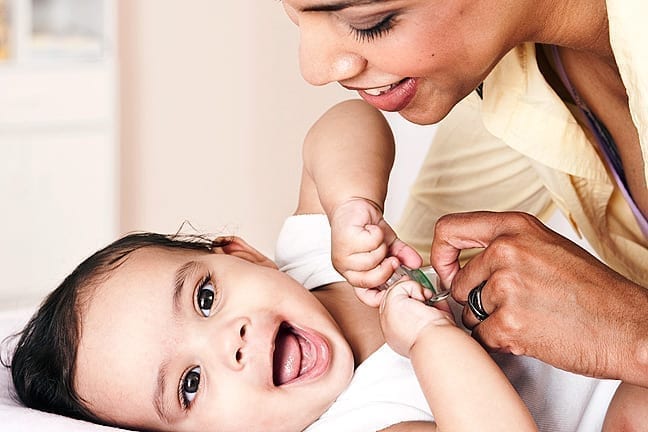Since my last column, my wife and I welcomed our second child, a beautiful baby girl, into this world. What a thrill!We have only two children, but having kids reminds you that there’s a huge chasm between what you “know” intellectually about love (and other emotions) and what you experience firsthand when your child is born. All I can say is this: It’s just unreal. By unreal, I mean one of the most intense emotional experiences you can possibly have—you fret and fret until, hopefully, you exalt.
When you stare into an infant’s eyes you can’t help but reflect on the meaning of life. What will this little hiccupping bundle of joy and wet diaper become?
I also can’t help but be a psychologist about this, and I ask myself over-and-over again: What is the most important thing we can do to ensure her wellbeing in the future? Nothing is guaranteed in this life, of course, but is there anything I know as a psychologist and as a scientist to help give her a good start in this world?
If I must rely on just one core idea, here’s what I’ve come up with: attachment theory.
Attachment theory is a framework for understanding human bonding. The theory was first outlined by the British psychiatrist, John Bowbly, and later extended by the American psychologist, Mary Ainsworth. The theory has many, many layers but I want to highlight three of the most central ideas:
- Our earliest caregiving experiences set the stage for how we come to think about relationships. From our early experiences, we develop what scientists refer to as internal working models of relationships and ourselves in relationships. Can caregivers be relied upon? Do I have a secure base to explore the world? Can I express my emotions to others in order to get what I need? Are relationships rewarding and fundamentally good, or are they fraught with difficulties and disappointments? For infants and young children, these questions are not pondered consciously; rather, the answers are learned through repeated experiences with caregivers in the context of their earliest relationships.
From these early relationships, we develop templates for thinking about future relationships, and these templates guide our behaviors in so many different situations that it’s sort of mind-boggling. (More on this later.)
- Based on caregivers’ sensitivity and responses to children’s needs, we observe the emergence of an attachment bond. The attachment bond is, in essence, the glue of a relationship. When infants become attached to a caregiver, they preferentially direct their affection to that one person, seek proximity to her/him, and become distraught when their attachment figure (AF) is unavailable.
The attachment bond is typically observed in one of three different patterns, all of which hinge in large part on caregiver sensitivity and responsivity. Secure children are the recipients of consistent care and comfort; they become upset in the absence of their AFs but are easily comforted upon reunion. Secure children come to see relationships as good and AFs as reliable. This sense of security underlies how they think about relationships in general.
The other two patterns reflect greater insecurity. Children who are highly anxious received inconsistent caregiving, and this results in an approach-avoidance conflict in which these kids want the care of their AFs but often refuse to let themselves be calmed or soothed by that person. Anxious children often have conflicted feelings about their AFs. Preoccupation about whether a caregiver will be available when needed often defines how anxious kids think about relationships.
READ MORE: Love is a Beauty Treatment
The other type of insecurity is attachment avoidance, which emerges when caregivers fail to provide consistent and nurturing care for a child. Children high in avoidance learn they cannot depend on their caregivers to alleviate their distress, and they often become hyper self-reliant. In essence, kids high in avoidance minimize relationships; AFs cannot be relied upon, and, therefore, it’s best not to get upset when they’re unavailable. For highly avoidant kids, it’s easier to just rely in yourself and not turn to others when dealing with strong emotions.
- These patterns, formed in our earliest relationships, get carried forward into how adults think about and act in their closest relationships. (To learn more about your current attachment style, see this YouBeauty.com quiz.) Attachment is not destiny. We are not doomed to fail in our relationships if we had a rocky childhood, nor are we programmed to succeed if we had highly nurturing caregivers. However, our attachment history becomes the stage on which all of our other relationship experiences play out—with our friends, with our lovers, and, ultimately, with our own children. In fact, there’s a classic study demonstrating that you can predict a child’s attachment pattern (at 1 year of age) with a high degree of accuracy based on how her/his mother thinks about her own attachment history when pregnant.
If you are a parent, grandparent, godparent, aunt/uncle or sibling of a newborn, what do you want most in the world for this little person? I am going to take a guess here: You want this kid to be happy. How do you set the stage for this happiness? Lots of things you can do, but if you, as a potential AF, can be available, present, nurturing and responsive, you can help instill the very basic ideas that relationships are good, that other people are trustworthy and reliable, and that a sense of security can be found in relationships.
If a child comes to think this way, it makes life unquestionably easier. So much of our happiness depends on our relationships. The best we can do for our kids is to plant the seeds of security, then watch them blossom.Copyright David A. Sbarra, Ph.D., July 4, 2011




































